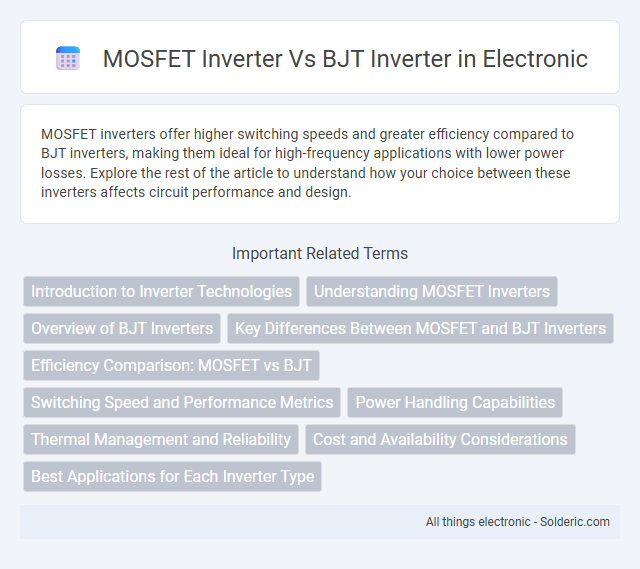MOSFET inverters offer higher switching speeds and greater efficiency compared to BJT inverters, making them ideal for high-frequency applications with lower power losses. Explore the rest of the article to understand how your choice between these inverters affects circuit performance and design.
Comparison Table
| Feature | MOSFET Inverter | BJT Inverter |
|---|---|---|
| Switching Device | MOSFET (Metal-Oxide-Semiconductor Field-Effect Transistor) | BJT (Bipolar Junction Transistor) |
| Input Control | Voltage-controlled | Current-controlled |
| Power Consumption | Low gate drive power | Higher base current required |
| Switching Speed | Faster switching, higher frequency operation | Slower switching speed |
| Output Characteristics | High input impedance, ideal for CMOS logic | Lower input impedance |
| Voltage Drop & Efficiency | Lower ON resistance (R_DS(on)), higher efficiency | Higher saturation voltage (V_CE(sat)), lower efficiency |
| Thermal Stability | Better thermal stability, less thermal runaway risk | Susceptible to thermal runaway |
| Complexity in Biasing | Simple voltage-driven biasing | Requires proper current biasing |
| Common Applications | Digital circuits, power electronics, switched-mode power supplies | Amplifiers, analog circuits, simple switching |
Introduction to Inverter Technologies
MOSFET inverters utilize Metal-Oxide-Semiconductor Field-Effect Transistors, offering high switching speeds and low conduction losses, making them ideal for efficient power conversion. BJT inverters rely on Bipolar Junction Transistors, which provide strong current handling and robustness but suffer from higher switching losses and slower response times. The choice between MOSFET and BJT inverters depends on application-specific requirements such as switching frequency, efficiency, and thermal performance.
Understanding MOSFET Inverters
MOSFET inverters offer higher switching speeds and greater efficiency compared to BJT inverters due to their voltage-driven gate control and lower on-resistance. The MOSFET's insulated gate structure enables minimal gate current, reducing power loss and heat generation during operation. These characteristics make MOSFET inverters ideal for high-frequency applications and energy-efficient power conversion systems.
Overview of BJT Inverters
BJT inverters utilize bipolar junction transistors as switching devices, known for their current-driven input characteristic which influences their switching speed and power consumption. These inverters exhibit higher switching losses and slower response times compared to MOSFET inverters due to the charge storage effect in BJTs. Despite this, BJT inverters maintain robustness in high-voltage applications and cost-effectiveness for certain power ranges.
Key Differences Between MOSFET and BJT Inverters
MOSFET inverters offer faster switching speeds and higher efficiency due to their majority carrier operation and low ON resistance, making them ideal for high-frequency applications. BJT inverters rely on minority carrier injection, resulting in slower switching times and higher power dissipation, but provide strong current handling capabilities useful in low-frequency, high-current environments. The voltage-controlled nature of MOSFET gates versus current-controlled BJT bases also influences driver circuitry complexity and overall inverter design.
Efficiency Comparison: MOSFET vs BJT
MOSFET inverters generally exhibit higher efficiency than BJT inverters due to lower conduction losses and faster switching speeds, which reduce energy dissipation during operation. The MOSFET's majority carrier operation minimizes switching losses and allows for better thermal management, enhancing overall inverter performance. In contrast, BJT inverters suffer from higher saturation voltage and slower switching, leading to increased power loss and reduced efficiency.
Switching Speed and Performance Metrics
MOSFET inverters excel in switching speed due to their low gate capacitance and fast charge-discharge cycles, enabling higher frequency operations compared to BJT inverters. Performance metrics such as switching losses and power efficiency are significantly better in MOSFET inverters, as BJTs suffer from longer storage times and higher saturation voltages. Consequently, MOSFET inverters are preferred in high-speed, high-efficiency power electronics where rapid switching and minimal energy loss are critical.
Power Handling Capabilities
MOSFET inverters exhibit superior power handling capabilities compared to BJT inverters due to their high input impedance and lower on-resistance, which results in reduced conduction losses and improved efficiency. MOSFET devices can operate at higher switching frequencies and handle larger currents with better thermal performance, making them ideal for high-power applications. In contrast, BJT inverters often suffer from higher saturation voltage and slower switching speeds, limiting their power handling capacity and efficiency in demanding circuits.
Thermal Management and Reliability
MOSFET inverters generate less heat due to lower on-state resistance compared to BJT inverters, enhancing thermal management and reducing cooling requirements. Their higher switching efficiency and reduced power loss contribute to improved reliability and longer operational lifespan. Your choice of MOSFET inverters ensures better performance under thermal stress and minimizes failure risks in demanding applications.
Cost and Availability Considerations
MOSFET inverters generally offer higher efficiency and faster switching speeds but tend to have a higher upfront cost compared to BJT inverters, which are often more affordable and widely available in various markets. You can find BJTs in a broad range of standard packages and are commonly used in low-cost, low-power applications, making them easier to source for budget-conscious projects. However, MOSFETs' growing popularity and production scale have improved their availability, narrowing the cost gap for many commercial uses.
Best Applications for Each Inverter Type
MOSFET inverters excel in high-frequency and high-efficiency applications such as switching power supplies, motor drives, and RF amplifiers due to their fast switching speed and low on-resistance. BJT inverters are preferred for linear amplification, audio amplifiers, and applications requiring higher current gain and robustness under thermal stress. Selection depends on specific requirements like switching speed, efficiency, and power handling capabilities.
MOSFET inverter vs BJT inverter Infographic

 solderic.com
solderic.com